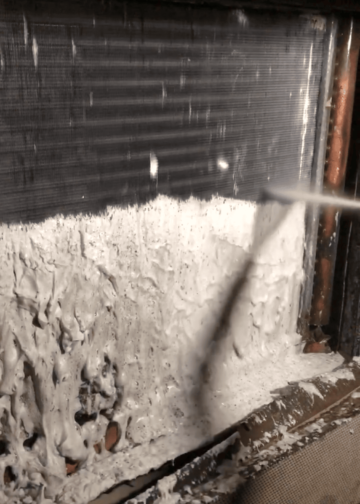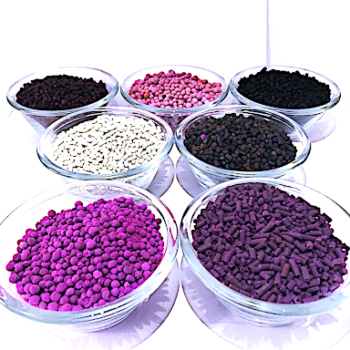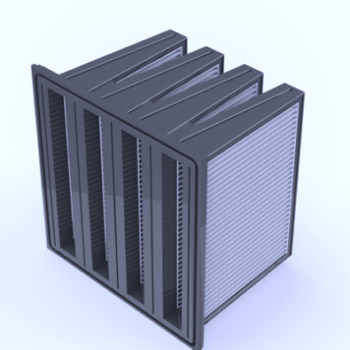It’s not out of place to raise the alarm on the quality of indoor air in airports
 Had it not been for the achievement of the Wright brothers, in North Carolina, and Bleriot’s last historic crossing of the English Channel, humankind would have been bound to the Earth’s surface. Over the past century, the aviation industry has gone from learning how to reach the sky to embracing how to fly safer, faster and farther, with heavier planes and greater passenger capacity. Today, the Federal Aviation Administration handles over 10 million scheduled flights, carrying an average of three billion passengers, annually[1]. According to the International Civil Aviation Organization (ICAO), “the demand for air transport is expected to increase by an average of 4.3% per annum over the next 20 years”[2]. ICAO also expects that “by mid-2030s, no fewer than 200,000 flights per day are expected to take off and land all over the world”.
Had it not been for the achievement of the Wright brothers, in North Carolina, and Bleriot’s last historic crossing of the English Channel, humankind would have been bound to the Earth’s surface. Over the past century, the aviation industry has gone from learning how to reach the sky to embracing how to fly safer, faster and farther, with heavier planes and greater passenger capacity. Today, the Federal Aviation Administration handles over 10 million scheduled flights, carrying an average of three billion passengers, annually[1]. According to the International Civil Aviation Organization (ICAO), “the demand for air transport is expected to increase by an average of 4.3% per annum over the next 20 years”[2]. ICAO also expects that “by mid-2030s, no fewer than 200,000 flights per day are expected to take off and land all over the world”.
During the pandemic-induced lockdowns, we realised the importance of aviation to our economies in enabling trade, generating economic growth, creating jobs, and facilitating interconnectivity and tourism. Many air transport processes and practices need reinvigorating for the aviation industry’s transition to meet the 2030 United Nations Agenda of 17 Sustainable Development Goals (SDGs; now known as Global Goals). That would undoubtedly require mobility to embrace sustainable business models, technological innovation, efficient operations and approaches in all pillars of transport, particularly air transport. However, that comes at a cost – the scale, scope and speed of increased greenhouse gas emissions from international aviation impact airport terminals and many communities, especially those living nearby. Today, governments and regulators are pressured to curb aviation footprints by characterising outdoor and indoor air in and around airport terminals to quantify the impacts of aviation emissions on residential exposures.

Figure 1: Greenhouse gas emissions from aviation particularly impact communities living near airports
Air quality for airports
Typically, civil aviation requires airport terminals to be built according to international standards, encompassing navigational and meteorological systems and standard operational practices to minimise misunderstandings leading to errors or accidents. Exposure to polluted outdoor and indoor air can severely impact human health by causing dizziness, fatigue, and respiratory and cardiovascular diseases. Emissions in the vicinity of airports come from terminals, landing and take-off operations, aircraft auxiliary power units (APUs) and ground support equipment (GSE). For example, aircraft engine emissions consist of nitrogen oxides (NOx), volatile organic compounds (VOCs), hydrocarbons (HC), particulate matter (PM) and carbon monoxide (CO). Monitoring stations are installed to establish and manage models able to identify the contribution of airport activities to outdoor pollutant concentration.
Inside airport terminals, human occupants are exposed to a wide array of pollutants with various concentrations and particle size distribution. These pollutants can contaminate the terminal’s indoor air and pose a hazard to passengers, staff and visitors. Therefore, continuous air quality monitoring through functional and reliable sensors will prove invaluable in protecting the human occupants in the terminals. In addition, airport terminals are designed to accommodate large and fluctuating human occupancy. That would influence the complexity of HVAC systems and the required controls to respond to the variation in Indoor Air Quality (IAQ) and heat loads. Therefore, for evaluating the thermo-physiological health of occupants in airport-constructed environments, quantifying the dynamic sensible and latent heat gains is essential. Additionally, modelling and comprehending the fluctuation in heat loads aid HVAC designers in anticipating and incorporating the time, space and human occupancy features impacting the total thermal comfort.
Physical and chemical characterisation of outdoor air around the terminals would help tweak filter selection and the number of stages required to render the air safe to breathe. Furthermore, functional ventilation systems, providing appropriate air exchanges per hour, can be critical to IAQ characteristics while observing indoor temperature and humidity levels. They would also help protect data centres, control rooms and towers served by HVAC and filtration systems.
Although leak-free ducts and efficient filter installation minimise particle deposition on heating/cooling coils, ducts and air diffusers, these HVAC segments must be cleaned and disinfected regularly. Therefore, visual inspections of HVAC equipment are essential to their professional operation, including pressure gauges’ intact functionality to ensure on-time filter replacement. In addition, the dampened nature of coils makes them prone to foster microorganism growth. Hence, maintenance teams should be attentive to their operational conditions.

Figure 2: Coil washing and disinfection to maintain its cleanness and performance
The uniqueness of each terminal
Each terminal’s uniqueness lies in its architectural design and HVAC and filtration requirements to make the travelling experience pleasant. Architecturally, airports are distinctive in the flow of passengers during arrival, departure and transit. Other considerations include the personal hygiene and health conditions of individuals using the terminal. Furthermore, the geographic location and climatic conditions can impact many design aspects of airport terminals, especially HVAC equipment and filtration systems. Ultimately, it is challenging to make sweeping conclusions that what works for a specific airport also works for others. However, understanding HVAC and air quality requirements is critical to better serve an airport terminal’s particular nature, operational challenges and occupants’ thermal requirements.
A great deal to safeguard
An integrated air quality control approach based on real-time monitoring is the way forward to enhanced and sustainable HVAC systems and filter performance. IAQ data collection will help understand the daily variation in IAQ parameters relevant to different physical activity patterns and the flow of passengers. The oscillation in particulate and gaseous contaminant concentrations can be managed if the performance of the HVAC and filtration systems are adaptive and based on data that drives how we mitigate air quality. Such management can play a significant role in rendering an airport terminal green and clean to occupy.
Conceptually, passengers, visitors and staff opt for clean airport terminals with the best air quality and a thermally comfortable built environment. However, the air quality inside terminals should not only revolve around CO2 but also entail other solid and gaseous pollutants, when present at harmful concentrations. Therefore, the appropriate employment of chemical filters to reduce the concentration of gaseous pollutants is paramount to tackle the gaseous pollutants.
Poor IAQ in densely occupied indoor spaces in airports can impact the wellbeing of passengers, visitors and staff. Therefore, inappropriate and insufficient filtration and ventilation can lead to deteriorated IAQ. Thus, ventilation systems must operate even when airport terminals have low or no human occupancy to avoid stagnant air and any possible mildew build-up on the facilities or equipment, thus reducing virus propagation. In addition, moisture control is another critical aspect that impacts the thermal comfort of indoor occupants, since it varies with human vapour and their breathing patterns.
Multi-stage filtration
As the concentration of multiple pollutants is found near airport terminals, the role of multi-stage filtration and extended air filters becomes well-pronounced. First, reducing the concentration of suspended particles from the outdoor intake air is critical to ensure that the depth deposition of particles is intact, extending the stationary filtration, particularly in regions sustaining frequent sandstorms. Appropriate multi-stage filtration can prove invaluable to the energy efficiency of air filter performance. It can also reduce the possibility of particle-bridging and premature surface deposition, which may impair fibrous filters from being used to their full potential. Furthermore, in the Sahara, in Africa, for instance, silica dust is a dominant element in the chemical composition of airborne dust, which can impact the wellbeing of human occupants when inhaled at higher concentrations with longer exposures.
 Figure 3: Chemical filters find their permanent spots in the filtration systems where gaseous contaminants exist
Figure 3: Chemical filters find their permanent spots in the filtration systems where gaseous contaminants exist
 Figure 4: A typical design of extended surface air filter cartridges commonly used in airport terminals
Figure 4: A typical design of extended surface air filter cartridges commonly used in airport terminals
Air diffusion
Air diffusion represents the last stage of the HVAC system where equal delivery of clean and comfortable air is required. Therefore, airflow dynamics and diffusions patterns are essential to achieving thermal comfort while reducing virus transmission to protect the health and safety of the human occupants. Many efficient air filters can help prevent or reduce the spread of viruses by lowering the concentration of indoor air pollutants if their design and media selection fit the filtration purpose. Additionally, HVAC and filtration experts should address the lifecycle impacts of filter performance and continuous air quality monitoring with HVAC system energy efficiency considerations, as they are not mutually exclusive.

Dr Iyad Al-Attar
Several challenges confront air quality assessments in airports, such as the fluctuations in human occupancy and physical activity, which is typical of the terminal environment. That may strain the air quality and increase the heat load and ventilation requirements, which calls upon “zoning” to allow for individual temperature control. In addition, many airports rely on enhancing vertical ventilation to discharge hot air near the ceiling to save energy for heating and cooling consumption. However, the complex nature of the co-existence of airborne pollutants in the vicinity of airport terminals makes assessing air filter performance challenging, not to mention the obtained air quality. When solid and gaseous pollutants deposit on air filter media, a possible interaction between deposited particles/pollutants and the filter media, which may off-gas a by-product, cannot be ruled out. To better assess these challenges, continuous air quality monitoring is required to identify possible repetitive contamination patterns and to deploy optimum mitigation strategies. That could entail installing other purification and disinfection technologies within the HVAC systems and the built environment. However, the success of these technologies lies in their certified performance and appropriate employment. Conceptually, a holistic approach is needed to comprehensively enhance the IAQ in airports by reducing the potential risks of airborne pollutants.
Eventually, we all aspire to achieve better air quality in airport terminals to protect the wellbeing of passengers and staff in the building. Indoor air characterisation and monitoring are vital for accurate filter performance and lifetime prediction. In addition, safeguarding occupants’ health requires knowing what our filtration systems are up against to optimise HVAC operational schemes for better IAQ while reducing energy usage and maintenance operations.
Going the extra mile
In modern airports, designers perceive airports not only as travel platforms but also as exciting gateways to relax, dine and shop while awaiting their next flight. Modern and future airports will transform the perception of the conventional terminal with simple seats and multiple gates to healthy built environments with full-fledged facilities that offer outstanding service and comfort standards. First, however, designers must embrace adaptive HVAC and second-to-none air filter performance equipped with outdoor and indoor aerosol monitoring systems that measure, track and control airport air quality around the clock. Going the extra mile starts with meeting the unique needs of such complex airport terminals, which requires specialised expertise to raise the bar of air quality by controlling and mitigating emissions. Today’s paradox of our airports is that we install ordinary air filters and expect extraordinary IAQ. Until that changes, we must have our boarding passes, passports and personal masks ready before the final call.
References:
[1] Federal Aviation Admission. https://www.faa.gov/data_research/aviation_data_statistics
[2] International Civil Aviation Organization. https://www.icao.int/Meetings/FutureOfAviation/Pages/default.aspx
Unless otherwise referenced, images are copyright of the author.
Copyright © 2006-2025 - CPI Industry. All rights reserved.